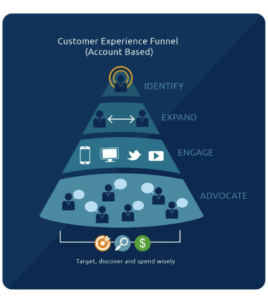When B2B sales teams close a deal, they “close an account” – it is time that Marketing teams line up around this account orientation.
What is Account-Based Marketing?
Account based marketing (ABM) is a B2B marketing and sales process that begins with a focus on accounts rather than only on ‘leads’ or people. Rather than primarily using the conventional method of casting a wide net to reach potential leads, ABM “flips the funnel” and starts with a focus on specific target companies or accounts that sales is pursuing or managing.
Account sales focus on larger transactions and involve team sales to a committee of buyers. More stakeholders are involved in the decision process and this lengthens the cycle and adds complexity. Success requires engagement with tailored messaging for different personas based on their role in the buying process. Marketing and sales teams work together developing valued account intelligence and targeted campaigns and programs focused on the specific account portfolio.
Some History on Account Based Marketing
In the 1990s B2B and B2C companies noticed the lack of personalized marketing. In those days, The One-to-One Future was published by Martha Rogers and Don Peppers, which advocated replacing the trend of mass marketing with a more personalized one-to-one form of communications. Since that time, account-based marketing has been growing to fulfill that 1:1 formula. B2B companies began using ABM strategies in one form or another and in 2004 the Information Technology Services Marketing Association (ITSMA) created the term “account-based marketing.” Bev Burgess, of ITSMA, co-created the term ABM with other organizations including HP, BT, Fujitsu and Accenture. Previously, it had been referred to as pipeline marketing or key account marketing.
Since the mid-2000s, there has been an increasing focus on the concepts around “Inbound Marketing”. The concepts around inbound marketing are great, yet they do not fully reflect the reality on the ground. While teams need to maximize the inbound marketing capabilities, B2B firms with complex products and services still require an extensive and effective outbound strategy. Account-based Marketing helps bring these more together with a coordinated marketing and sales effort around strategic accounts.
The Account-Based Marketing Approach
ABM begins with choosing and targeting key accounts. To select account targets, begin with criteria that drives your business and map account firmographic, and demographic information including sales/ revenue history, profitability and account history. Analyze the long-term relationship with the account and determine the potential to offer differentiated solutions to particular accounts. Align marketing and sales teams around a set of strategies and programs that engage these key accounts.
Teams can take advantage of the channels already in place, such as social, display, mobile and video. IP or cookie-based digital marketing pinpoints specific accounts that are visiting your website and engaging your content. You can integrate an ABM platform with a marketing automation tools that will help target accounts that already exist in the database. Through multi-channel ad campaigns and website customization, a company can engage specific accounts with tailored messaging. The results are that ABM can significantly increase the engagement relevance for each account. It aids in aligning marketing activities with the sales account strategies while getting the most value from integrated marketing. In the end, the customer comes out the winner with ABM by getting more personalized attention more tailored and compelling content experiences.
Some Emerging Technologies
A range of software solutions are emerging for account-based marketing. These include companies like Demandbase and Bizo (now part of LinkedIn Business Solutions) Engagio, Terminus Netprospex, Driftt, and Evergage,
Existing marketing automation tools like SharpSpring, HubSpot, Marketo and Pardot with Salesforce also facilitate account-based marketing while also supporting the traditional funnel marketing approach. It will be interesting to see how these platforms evolve to further enable the account-based marketing process.
ABM and Closed Loop Marketing Architecture™
Revenue Architects has developed a process to help engage customers by continually delivering custom-made omni-channel experiences. The Closed Loop Marketing Architecture (CLMA) addresses the most critical segments and flow of sales and marketing campaigns, which in turn drive growth. This is done by aligning sales and marketing efforts and integrating complex software, media and channels. The loop is closed when sales are tracked and attributed and teams align around the end-to-end life cycle of the customer. (Download the Closed Loop Marketing Architecture – A Blueprint for designing integrated campaigns)



